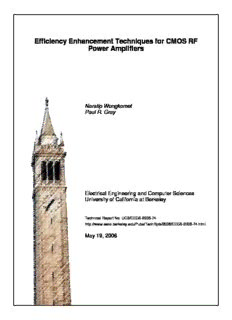
Efficiency Enhancement Techniques for CMOS RF Power Amplifiers PDF
Preview Efficiency Enhancement Techniques for CMOS RF Power Amplifiers
Efficiency Enhancement Techniques for CMOS RF Power Amplifiers Naratip Wongkomet Paul R. Gray Electrical Engineering and Computer Sciences University of California at Berkeley Technical Report No. UCB/EECS-2006-74 http://www.eecs.berkeley.edu/Pubs/TechRpts/2006/EECS-2006-74.html May 19, 2006 Copyright © 2006, by the author(s). All rights reserved. Permission to make digital or hard copies of all or part of this work for personal or classroom use is granted without fee provided that copies are not made or distributed for profit or commercial advantage and that copies bear this notice and the full citation on the first page. To copy otherwise, to republish, to post on servers or to redistribute to lists, requires prior specific permission. Efficiency Enhancement Techniques for CMOS RF Power Amplifiers by Naratip Wongkomet B.Eng. (Chulalongkorn University, Thailand) 1998 M.S. (Georgia Institute of Technology) 1999 A dissertation submitted in partial satisfaction of the requirements for the degree of Doctor of Philosophy in Engineering-Electrical Engineering and Computer Sciences in the GRADUATE DIVISION of the UNIVERSITY OF CALIFORNIA, BERKELEY Committee in charge: Professor Paul R. Gray Professor Ali Niknejad Professor Paul K. Wright Spring 2006 The dissertation of Naratip Wongkomet is approved: _____________________________________________________ Professor Paul R. Gray, Chair Date _____________________________________________________ Professor Ali Niknejad Date _____________________________________________________ Professor Paul K. Wright Date University of California, Berkeley Spring 2006 Efficiency Enhancement Techniques for CMOS RF Power Amplifiers Copyright © 2006 by Naratip Wongkomet Abstract Efficiency Enhancement Techniques for CMOS RF Power Amplifiers by Naratip Wongkomet Doctor of Philosophy in Engineering – Electrical Engineering and Computer Sciences University of California, Berkeley Professor Paul R. Gray, Chair Growth in the wireless communication market in recent years has been driving the demand for higher integration of CMOS wireless transceivers in order to achieve lower cost, smaller form factor, and more functionalities. Much recent research effort has demonstrated the feasibility to integrate most transceiver building blocks into a single CMOS die. One of the few remaining blocks that has yet to be successfully integrated is the Power Amplifier (PA). The PA is usually the last active building block in a radio transmitter. Its function is to amplify the signal power up to the required level before it can be transmitted into the air. Due to several limitations of CMOS technology, designing a linear and efficient PA is a challenging task. A property shared among most PAs is that the maximum power efficiency is achieved only when the PA is transmitting peak output power. Efficiency degrades dramatically as output power decreases. Under typical operating conditions, the PA transmits well below its peak output power, therefore the 1 effective efficiency is much lower than the maximum value. This thesis applies a concept first developed in the vacuum tube era by William H. Doherty to improve amplifier efficiency over a wide range of output power to the CMOS PA problem. Several circuit techniques are also explored in order to optimize efficiency and linearity of CMOS PA, and to allow a high level of integration. A highly integrated PA prototype was designed in a 0.13μm CMOS technology. It is designed to operate in the cellular DCS1800 band, which has the transmit frequency between 1710MHz and 1785MHz. With GMSK modulated signal, the prototype achieves +31.8dBm output power with 36% power-added efficiency (PAE). The PAE stays above 18% over 10dB range of output power. The PA also meets the GSM/EDGE spectral mask requirement at +25dBm output power with 13% PAE. _________________________________ Paul R. Gray, Chairman of the Committee 2 Table of Contents Chapter 1: Introduction 1 1.1 Motivation 1 1.2 Power Amplifier in Modern Wireless Applications 3 1.3 Research Goals 4 1.4 Thesis Organization 7 Chapter 2: RF Power Amplifier Fundamentals 8 2.1 Power Amplifier Basics 9 2.2 Power Efficiency 10 2.3 Linearity 13 2.3.1 AM-to-AM and AM-to-PM Characteristic 15 2.3.2 Spectral Mask 16 2.3.3 Adjacent Channel Leakage Ratio 17 2.3.4 Error Vector Magnitude 18 2.4 Typical PA circuit 19 2.5 Power Amplifier Classes 21 2.5.1 Class A Amplifier 21 2.5.2 Class AB,B, and C Amplifiers 24 2.5.3 Class D Amplifier 27 2.5.4 Class E Amplifier 29 2.5.5 Class F Amplifier 30 Chapter 3: Power Amplifier Enhance Techniques 34 3.1 PA Enhancement Techniques 35 3.2 Efficiency Enhancement Techniques 36 3.2.1 Doherty Amplifier 37 3.2.2 Power Supply Variation 40 3.2.3 Bias Adaptation 42 i 3.3 Linearization Techniques 43 3.3.1 Feedback 43 3.3.2 Predistortion 46 3.3.3 Envelope Elimination and Restoration (EER) 47 3.3.4 Chireix’s Outphasing 48 Chapter 4: Doherty Amplifier 51 4.1 Doherty Amplifier Block Diagram 52 4.2 Passive Impedance Inverter (Z ) 53 inv 4.3 Doherty Amplifier Operation 54 4.4 Linear Doherty Amplifier 63 4.5 Effect of Lossy Z Network 67 inv 4.6 Tuning of Z Network 70 inv 4.7 Nonlinear Doherty Amplifier 72 4.8 Effect of Load Variation 75 4.9 Multi-stage Doherty Amplifier 77 Chapter 5: Linear Amplifier Design 79 5.1 Linear Output Stage Design 81 5.2 Linear Output Stage with Cascode Transistor 95 5.3 Driver Stage Design 97 5.4 Capacitive Neutralization Technique 99 5.5 Interstage Matching 105 5.6 Output Matching Network 107 Chapter 6: CMOS Protype and Experimental Results 114 6.1 Doherty Amplifier Building Blocks 114 6.1.1 Polyphase Circuit 115 6.1.2 Main and Auxiliary Amplifiers 117 6.1.2.1 Output Stage 118 6.1.2.2 Interstage Matching 121 ii 6.1.2.3 Predriver and Driver 123 6.1.3 Output Matching Network 124 6.1.4 Impedance Inverter Network 127 6.1.5 Switched Capacitor Array 129 6.2 Overall Simulation Results 134 6.3 CMOS Prototype 137 6.4 Experimental Results 138 Chapter 7: Conclusion 142 References 144 iii
Description: